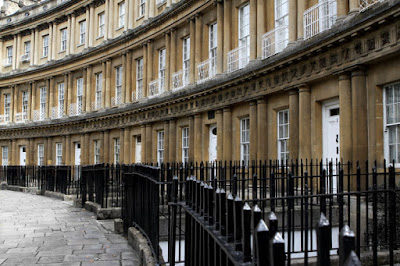 “Georgian townhomes of Bath stone standing row upon row.” I wrote that in yesterday’s post on Door Personality, so today I thought I would show you what I meant with an image. There is wonderful symmetry in this place, the Circus in Bath. (Circus really just means “circle” for us American English speakers. No trapeze acts here.) A circle of houses, all built to the same design, using the local Bath stone. I originally tried converting this to black and white but you lose the warm color of the stone, so instead I just did some selective black and white to take out a tiny bit of distracting green from a few plants. I love the repeating patterns and lines along the curve of the street.
“Georgian townhomes of Bath stone standing row upon row.” I wrote that in yesterday’s post on Door Personality, so today I thought I would show you what I meant with an image. There is wonderful symmetry in this place, the Circus in Bath. (Circus really just means “circle” for us American English speakers. No trapeze acts here.) A circle of houses, all built to the same design, using the local Bath stone. I originally tried converting this to black and white but you lose the warm color of the stone, so instead I just did some selective black and white to take out a tiny bit of distracting green from a few plants. I love the repeating patterns and lines along the curve of the street.
But in this place, there is no door personality. In this place, to maintain the original heritage of the site, the doors are all the same white, with very little room for personalization. This was a high end area (“posh” to use the British term) in it’s day, and still is now. Isn’t it interesting, that when you get to higher end neighborhoods, even in the USA, they are protected by covenants and rules and regulations to keep the look of them the same but also that reduces the opportunity for public expression. Granted, that is nice when you are a home owner and want the value of your property to remain high, but it’s also limiting.
So while I really love the lines and geometry of this place as art, it doesn’t give me the same heart-warming feel as yesterday’s door. I’ll add personality and non-conformity to the list of things that inspire me, like texture and peeling paint and imperfection. One more ray of light shed upon my soul through my photos.
PS – I forgot to mention on my Postcard Giveaway that I will be selecting the winner via random drawing. I am enjoying all of the convincing appeals that are coming through with the comments, however! You can still enter to win here until Sunday 5-Sep.










